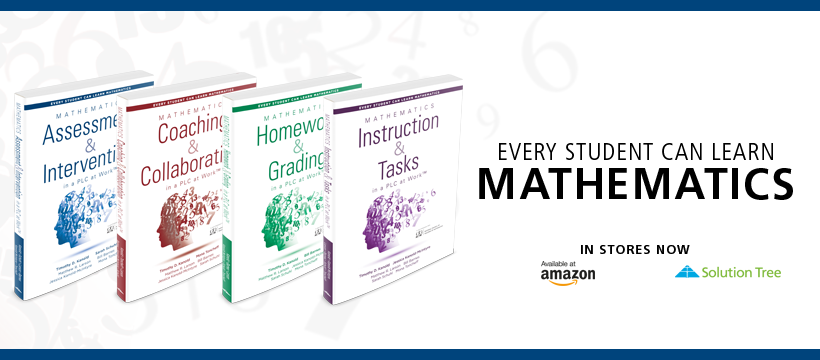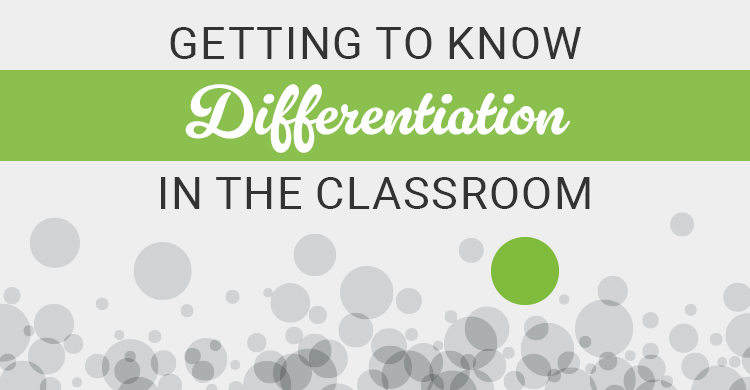Based on Mathematics Instruction and Tasks in a PLC at Work®
When I am in schools working with teachers of mathematics, the most common question I get is, “How do I use rich, higher-level-cognitive-demand tasks with each and every student? I know my students need access to more complex mathematical tasks, but how do I implement them well with all students?”
The answer to this question lies in establishing the foundation of a differentiation process during each mathematics lesson.
Definition of Differentiated Instruction in Mathematics
In mathematics, differentiation supports an individual student learning process not through the use of different lessons for each student, but through the intentional development of differentiation (scaffolding and advancing prompts provided by you and their peers).
Tomlinson and Allan (2000) defined differentiation this way:
“A teacher who is differentiating understands a student’s needs to express humor, or work with a group, or have additional teaching on a particular skill, or delve more deeply into a particular topic, or have guided help—and the teacher responds actively and positively to that need. The goal of a differentiated classroom is maximum student growth and individual success.”
To achieve the differentiation described by Tomlinson and Allan, both the choice of mathematical tasks to learn the standard for the day and the nature of the student discourse with peers need to be planned in advance of the lesson.
Instructional Strategies: The Need for Balance
Balancing Cognitive Demand
You begin to plan for a differentiated lesson by asking: What mathematical tasks will I use to engage students in the essential learning for today? How will I order the use of the tasks? How will I provide time for my students to process their thinking for each task?
Differentiation is an instructional shift requiring you to provide students with different (thus differentiating) entry or exit points to each mathematical task.
When you choose higher-level-cognitive-demand tasks to teach the standard, your students should not have a set of predetermined procedures to follow to reach a solution, or, if the tasks involve procedures, your students should explain why and how they perform the procedure or use a specific strategy.
Ultimately, higher-level-cognitive-demand mathematical tasks support increased student exploration, communication, and reasoning and allow for multiple solution pathways or representations (Kanold, et al, 2018).
Balancing Whole-Group and Small-Group Discourse
As you build procedural fluency on a foundation of conceptual understanding, strategic reasoning, and problem solving (NGA Center & CCSSO, 2010; NCTM, 2000, 2014) through task selection, there is another important lesson design question:
What type of student discourse will I use for the lesson each day? How will I balance the whole-group and small-group discussions with my students? Who is doing the talking? My student with each other, or me, as the teacher?
The manner in which you facilitate student discourse is essential in creating and supporting a classroom-learning environment that values reasoning and sensemaking from the student’s point of view. How you ask questions and facilitate discourse in your classroom has important implications for whether or not your classroom instruction promotes an equity culture.
Through the use of either whole-group or small-group discourse, you decide what thinking to share and whose voices to hear. This has a profound impact on how knowledge is shared and created in your classroom, how deeply the task engages students, how they will receive feedback during the task, and who plays a primary role in that knowledge sharing and creation. In short, your discourse affects student agency toward learning the mathematics.
There are several considerations for how students will experience the process of learning the mathematical tasks you chose:
- Will students watch you model the task, as you ask individual members of the class guiding questions from the front of the room? (i.e. whole-group discourse)
- Will your students discuss a strategy for working on the task with partners or in small groups as you circulate the room and provide differentiated feedback and prompts for perseverance? (i.e. small-group discourse)
- Or, will students use some combination of both lesson communication styles?
In the lesson design process, part of your professional responsibility is to ensure a daily balance of whole-group and small-group classroom discourse or discussions.
Implementation: Now What?
What happens when students get stuck and how do you know?
Part of the struggle with implementing higher-level-cognitive-demand mathematics tasks is maintaining student perseverance throughout the task. Have you ever had students shut down when you try something new in class or when you give them a problem they perceive as too hard for them? If you have, then you know it is not fun when it happens. It’s easy to think the problem was too hard and your students just can’t do “those types of math problems.”
Below are few questions to consider before you start the lesson to support perseverance:
- What types of misconceptions do you anticipate students will struggle with during the task?
- What types of scaffolding questions can you ask students to help guide their work on this task when they get stuck?
Unstucking and Advancing Prompts
In order to support student perseverance throughout a lesson, you can have “unstucking” and advancing prompts ready to go for each task of the lesson.
Unstucking prompts, also known as assessing or scaffolding prompts, are questions or statements you use to help students access the content or start the task if they are stuck. Advancing prompts are questions or statements you use to extend a task for a group of students who are demonstrating understanding (Kanold, et al, 2018).
For a student struggling to get started, consider asking:
- What do you know about the problem?
- What do you think you should do first? Then, what would you do after that?
- I like that I see _____, how could you add on to it?
For a group of students with different approaches, consider asking:
- Who agrees? Disagrees? Who will explain why or why not?
- Who has the same answer but a different way to explain it?
- Explain the strategy ___ used by your partner? How is it similar or different to your strategy?
Imagine taking a close look at what your students are doing as the mathematics lesson progresses. Are your students being expected to embrace their errors as they reflect, refine, and act on the in-class practice with their peers and with you?
Formative Assessment
One way to serve differentiation is via formative assessment processes in class.
According to W. James Popham (2011), the following occurs when during the lesson teachers use formative assessment and feedback well: It can essentially double the speed of student learning, producing large gains in students’ achievement. (p. 36)
Below are few questions to consider before you start the lesson to prepare for the formative assessment process:
- How do you plan to provide feedback to student solution pathways and explanations?
- How will students work on the task with their peers and receive feedback from one another?
- How will you ensure all students take action on feedback received during the task? (Kanold, et al, 2018)
Your best opportunity to see and hear how students are thinking, monitor that student thinking and learning, and provide formative feedback occurs when students are working in small groups on mathematical tasks with their peers as you monitor the student teams to see and hear what they are doing and thinking.
Douglas Reeves (2011, 2016) and John Hattie (2009, 2012) provide insight into four essential characteristics of meaningful feedback that create a basis for effective formative feedback to students. The key is making your feedback FAST (fair, accurate, specific, and timely) and actionable. Students must take action on the feedback you provide to truly make large gains in their learning.
In summary, differentiation in the mathematics classroom begins in the lesson-design process, but comes to life around the mathematical tasks used with students. Your intentional development and balanced use of higher-level cognitive demand tasks and small-group and whole-group discourse provide you the flexibility to scaffold your questioning and create opportunities for students to receive feedback.
References:
Hattie, J. (2009). Visible learning: A synthesis of over 800 meta-analyses relating to achievement. New York: Routledge.
Hattie, J. (2012). Visible learning for teachers: Maximizing impact on learning. New York: Routledge.
Kanold, T. D., Schuhl, S., Larson, M. R., Barnes, B., Kanold-McIntyre, J., & Toncheff, M. (2018). Mathematics instruction and tasks in a PLC at Work. Bloomington, IN: Solution Tree Press.
National Council of Teachers of Mathematics. (2000). Principles and standards for school mathematics. Reston VA: Author.
National Council of Teachers of Mathematics. (2014). Principles to actions: Ensuring mathematical success for all. Reston, VA: Author.
National Governors Association Center for Best Practices & Council of Chief State School Officers. (2010).Common core state standards for mathematics. Common core state standards (college- and career-readiness standards and K–12 standards in English language arts and math). Washington, DC: Author.
Popham, W. J. (2011). Transformative assessment in action: An inside look at applying the process. Alexandria, VA: Association for Supervision and Curriculum Development.
Reeves, D. (2011). Elements of grading: A guide to effective practice. Bloomington, IN: Solution Tree Press.
Reeves, D. (2016). Elements of grading: A guide to effective practice (2nd ed.). Bloomington, IN: Solution Tree Press.
Tomlinson, C. & Allan, S. (2000). Leadership for differentiating schools and classrooms. Alexandria, VA: Association for Supervision and Curriculum Development.[author_bio id=”171″]






